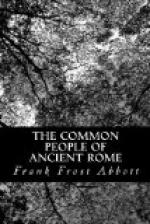All these gifts were for the city of Rome, and for the people of the city, not for the Empire, nor for Italy. This is characteristic of ancient generosity or philanthropy, that its recipients are commonly the people of a single town, usually the donor’s native town. It is one of many indications of the fact that the Roman thought of his city as the state, and even under the Empire he rarely extended the scope of his benefactions beyond the walls of a particular town. The small cities and villages throughout the West reproduced the capital in miniature. Each was a little world in itself. Each of them not only had its forum, its temples, colonnades, baths, theatres, and arenas, but also developed a political and social organization like that of the city of Rome. It had its own local chief magistrates, distinguished by their official robes and insignia of office, and its senators, who enjoyed the privilege of occupying special seats in the theatre, and it was natural that the common people at Ostia, Ariminum, or Lugudunum, like those at Rome, should expect from those whom fortune had favored some return for the distinctions which they enjoyed. In this way the prosperous in each little town came to feel a sense of obligation to their native place, and this feeling of civic pride and responsibility was strengthened by the same spirit of rivalry between different villages that the Italian towns of the Middle Ages seem to have inherited from their ancestors, a spirit of rivalry which made each one eager to surpass the others in its beauty and attractiveness. Perhaps there have never been so many beautiful towns in any other period in history as there were in the Roman Empire, during the second century of our era, and their attractive features—their colonnades, temples, fountains, and works of art—were due in large measure to the generosity of private citizens. We can make this statement with considerable confidence, because these benefactions are recorded for us on innumerable tablets of stone and bronze, scattered throughout the Empire.
These contributions not only helped to meet the cost of building temples, colonnades, and other structures, but they were often intended to cover a part of the running expenses of the city. This is one of the novel features of Roman municipal life. We can understand the motives which would lead a citizen of New York or Boston to build a museum or an arch in his native city. Such a structure would serve as a monument to him; it would give distinction to the city, and it would give him and his fellow citizens aesthetic satisfaction tion But if a rich New Yorker should give a large sum to mend the pavement in Union Square or extend the sewer system on Canal Street, a judicial inquiry into his sanity would not be thought out of place. But the inscriptions show us that rich citizens throughout the Roman Empire frequently made large contributions for just such unromantic purposes. It is unfortunate that a record of the




